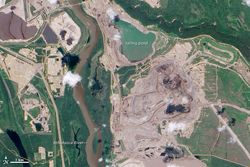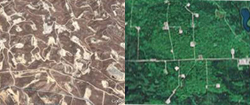Comparing Land Use Impacts of Petroleum and Biofuels
The biofuels industry claims its fuel is unfairly singled out by a new policy focus on greenhouse gas emissions associated with land use change. It argues petroleum has land use change impacts, too. Now, in an effort to contribute to scientific understanding and political discourse, an international research team led by ITS-Davis research engineer Sonia Yeh has published one of the first estimates of land use change GHG emissions from petroleum production. The study appears in Environmental Science & Technology.
|
|
|
Oil sands operation in Athabasca, Alberta, |
Their findings conclude that emissions released from land disturbed by certain fossil fuels extraction methods can be comparable to or higher than emissions from land disturbed by farming crop-based biofuels—when measured as tons of carbon emitted per unit of land disturbed. However, when measured per unit of energy produced, the land impacts of even the most high-impact fossil fuels are a tiny fraction of those of biofuels. “We started this because of the current policy debates,” says Yeh, who acknowledges that regulators and researchers believed the land use impacts of petroleum production were minimal when compared to biofuels. She and her team, under contract with the California Air Resources Board, set out to test the belief.
“It turns out that while many researchers have looked at land use impacts of biofuels, few have looked at the land use impacts associated with oil.” The research team focused on the land use impacts of heavy crude oil extracted in California and in the Canadian oil sands in Alberta. The study examined conventional extraction methods such as drilling, which occurs in California and Alberta, and non-conventional extraction methods in Alberta. Non-conventional extraction methods include surface strip mining of the bitumen soil and in siturecovery where steam is injected into a deep well. The researchers first estimated the amount of land impacted by the different processes, then calculated the GHG emissions from the land disturbances.
|
|
|
Conventional oilfields in California and |
To estimate the amount of land affected by conventional processes—about half of Alberta’s output is conventional—they applied a custom software program to Google Earth images of the land disturbances such as well pads, pipelines, access roads, and seismic surveys. They found that the land use impacts of conventional oil extraction methods are limited, compared to non-conventional oil sands processes. To estimate the land use impacts of oil sands processes, the study relies on earlier findings of co-authors Sarah Jordaan and David Keithfrom the University of Calgary.
Land disturbance for in situ recovery includes central processing facilities and networks of seismic lines, roads, pipelines, well pads, and upstream land use disturbance for natural gas production (a key fuel used in the in situ production process). In surface mining, a large area is cleared of all vegetation and excavated. The total land disturbance includes a mine site, overburden storage, and “tailings” ponds, which not only cover large areas of land but are also high in chemical wastes and toxic substances.
The team found the impacts of the oil sands processes can be significant for three reasons. First, the surface mining process disturbs enormous amounts of land that is rich in carbon deposits. “The biggest factor is the significant portion of peat lands disturbed in Alberta,” explains Yeh. They estimate roughly 23% of the land for oil sands extraction is peat land. A similar percentage of land involved in conventional extraction is also on peat land. “Peat lands accumulate carbon over thousands of years, and the average carbon per hectare stored in boreal peat land is six times that stored in non-peat forest.”
Second, only 12% of the total oil sands surface mining area in Alberta is reported as reclaimed, which means the land impact is prolonged.
Third, the use of tailings ponds makes the land unavailable for reclamation and carbon sequestration.
“These ponds have potential to generate a lot of methane emissions,” Yeh adds, noting that methane is a potent GHG. Improved restoration practices could significantly reduce GHG emissions and therefore the land and GHG impact, says Yeh. Companies can reduce emissions from tailings ponds by employing innovative strategies to facilitate sedimentation, reduce tailings size, and more quickly return the land to its natural state.
Yeh co-led a team of UC Davis and UC Berkeley researchers who are technical advisors to California as it develops and implements its Low Carbon Fuel Standard. Together with ITS- Davis Director Dan Sperling, she is leading a team of national researchers from six prominent research institutions to evaluate the benefits of a national LCFS relative to other policy instruments and to design a national LCFS policy.
Thank you for your interest in the UC Davis Institute of Transportation Studies. Subscribe today to keep up with the latest ITS news and happenings.


